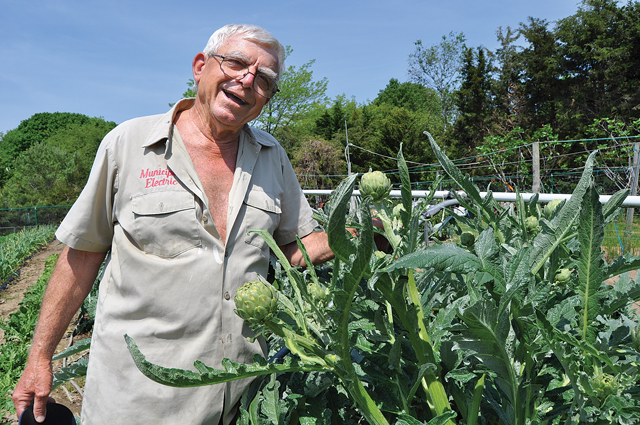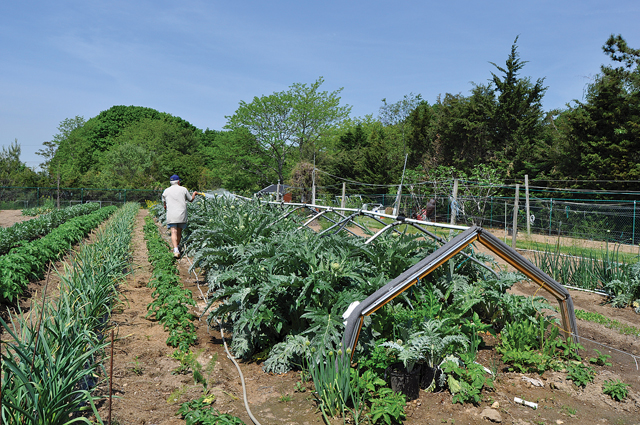Real Estate: The man with the ‘gold thumb’


He retired from his job as an electrician in 1999, but Nick Ranieri still averages an eight-hour workday.
Each morning, the 78-year-old Mattituck resident rises around 7 a.m. An hour or two later, he laces his white New Balance sneakers and retreats to his impressive backyard vegetable garden, where he spends the rest of the day painstakingly tending to the countless varieties of produce that flourish there.
“It’s what keeps me going,” said Mr. Ranieri, who immigrated to New York City in 1965 from his hometown of Mola di Bari, in Italy’s southeastern Puglia region. “I’m 78. This is good for your mind and your health, also.”
Mr. Ranieri doesn’t sell his fruit or vegetables to the public, opting instead to share his considerable bounty with family and friends and store any leftovers in the freezer. Nonetheless, strangers have taken notice of his 150-by-100-foot garden. In fact, Mr. Ranieri’s Old World practices are now being documented by the Italian Garden Project, a Pittsburgh organization whose mission, according to its website, is to “celebrate the joy and wisdom inherent in the traditional Italian-American vegetable garden, preserving this heritage and demonstrating its relevance for reconnecting to our food, our families, and the earth.”
Mary Ann Pietanza, a Staten Island writer who is helping the project document Mr. Ranieri’s garden through photos and interviews, said she heard about him through word-of-mouth.
“We were looking specifically for gardeners who are real intense,” Ms. Pietanza said. “They garden in such a way that they graft their trees … They’re very creative in their gardening practices.”
The ninth of 11 children, Mr. Ranieri believes his ancestors along the Adriatic Sea have likely always been farmers.
“In Puglia, the south of Italy, there is no industry,” he said. “In a town of 25,000 people, you have farming and fishing.”
According to Ms. Pietanza, southern Italians were once referred to as “the peasantry.”
“They were the farmers of the country,” she said. “They didn’t rely on education; they relied on the land.”
Mr. Ranieri’s parents, Vito Antonio and Pasqua, made a living selling artichokes and table grapes. But Mola di Bari’s variable weather and ancient wells eventually made Mr. Ranieri decide to relocate to the United States.
“They said it was a land of opportunity,” he recalled. “It was, especially the year I came here. And it still is.”

Despite leaving Italy behind, Mr. Ranieri literally brought a piece of home with him to America — in the form of chicory, Swiss chard and Roma tomato seeds. After he was hired as an electrician with Local Union 3, he and his wife, Rosa, settled in Flushing, Queens, with their two children, Pasqua and Anthony. In that urban environment, Mr. Ranieri cultivated a 30-by-30-foot vegetable garden.
“He worked a hard life and while working as an electrician he still had his garden,” said his daughter-in-law, Samantha Ranieri of Franklin Square. “He made sure that he kept it going.”
By 1986, Mr. Ranieri had discovered the North Fork. Enchanted, he purchased an 8.6-acre farm that same year in Northville, where he planted “whatever his family ate.” Sometimes, he recounted with a laugh, local potato farmers stopped their tractors to joke that he was putting them to shame.
Mr. Ranieri eventually sold his Northville property and in 2001 he and his wife bought a house in Mattituck. It was then, Ms. Ranieri said, that her father-in-law’s garden “exploded.”
Today, it’s difficult to discern just how many varieties of crops Mr. Ranieri grows on his 1.6-acre property in a cul-de-sac off Sound Road. In addition to 45 artichoke plants, he cares for 15 lemon trees and at least 30 other types of fruits, vegetables and herbs. During the winter, Mr. Ranieri tends to selected plants in his backyard greenhouse.
He still uses a homemade irrigation system he invented more than a quarter-century ago with PVC piping and he protects his artichokes from the cold by draping them with heavy sheets of plastic, using fans to promote air circulation. By doing so, he’s able to harvest the flowering vegetable one month earlier than usual.
“We always say he has a ‘gold’ thumb,” Ms. Ranieri said. “He is a scientist. His greenhouse is his lab.”
Mr. Ranieri has a particular penchant for grafting, a horticultural technique in which tissues from one plant are inserted into another so that they can be joined together. He has successfully used the practice to grow five types of pears on a single tree and nurse other trees back to health.
“He grafted a tree that was sick with a tree that was more disease-resistant so that he could make the tree that was dying healthier,” Ms. Pietanza recalled. “That’s pretty ingenious, I would say.”
In addition to concocting ways to accelerate the growing process, Mr. Ranieri spends time patiently educating his children and four grandchildren about the art of gardening.
“Unfortunately,” he pointed out, “times are different. I wish more young people would get into that, to carry some of that experience and the benefit of that. You guys today — computer, computer, computer. Nobody wants to do the physical work, but the physical work is good.”
For Ms. Pietanza, this makes the process of documenting Mr. Ranieri’s garden all the more important. Old World-style American farmers like him, she said, are getting older. Eventually, they’ll all be gone.
“It’s going to be a lost art,” she said.
Top Photo Caption: Artichokes are among the vegetables Nick Ranieri of Mattituck grows in his backyard garden. A native of Italy’s Puglia region, Mr. Ranieri’s Old World practices are being documented for the Italian Garden Project, a Pittsburgh organization that seeks to preserve Italian and American food and gardening traditions. (Credit: Rachel Young)








